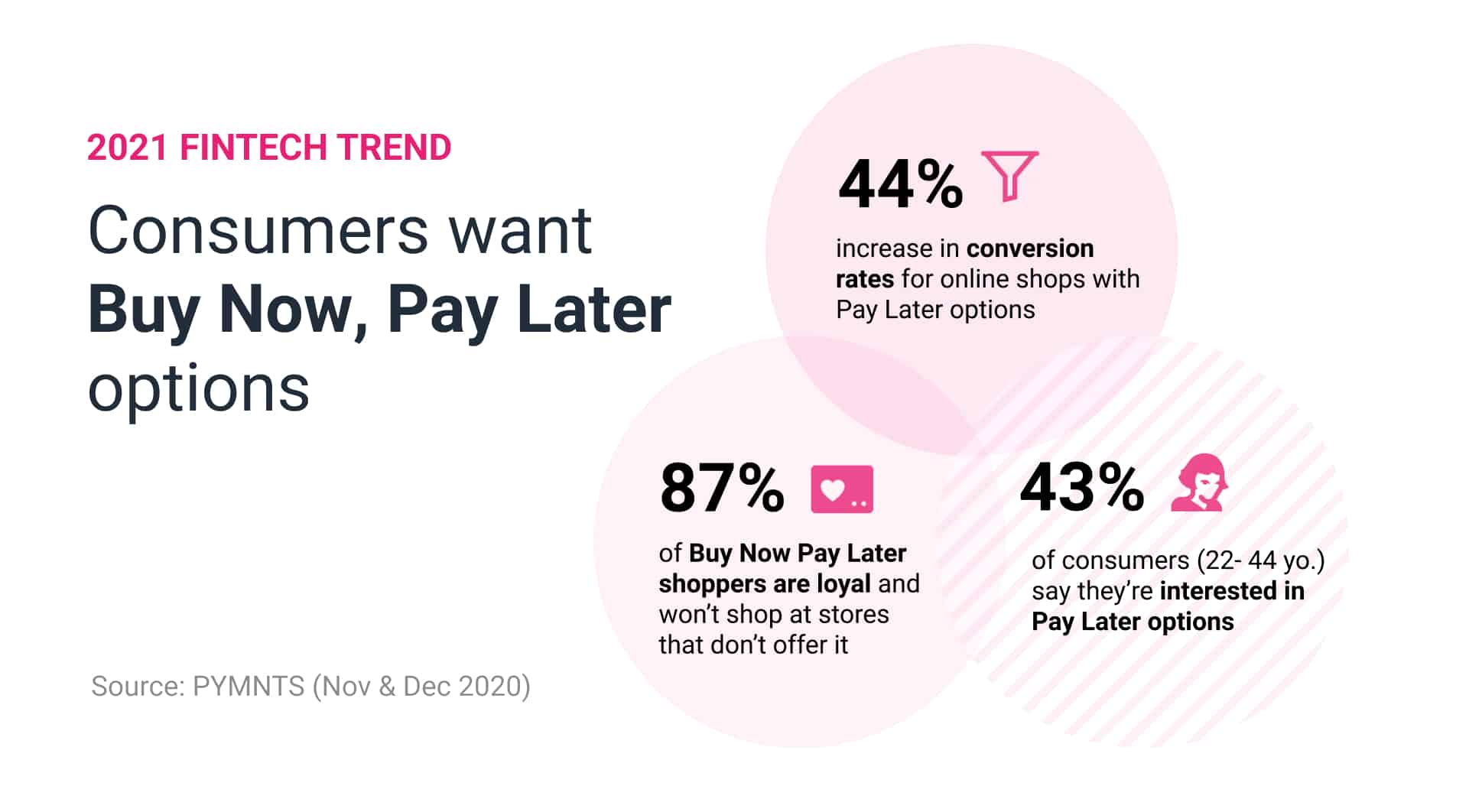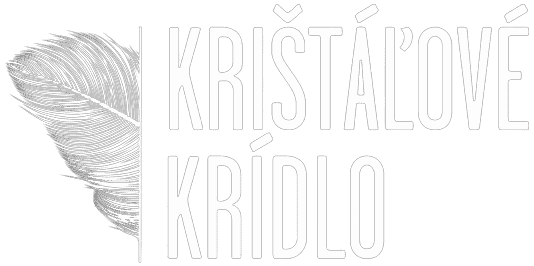December and January are traditionally the most expensive months for everyone. Holiday gift shopping and the accompanying credit card bills that come a month later are big hits to people’s bank accounts. But not for everyone.
More and more consumers choose a form of paying later or paying in installments. These delayed payment options, also known as ‘Buy Now, Pay Later’ (BNPL), offer a low or 0% interest rate of micro-credit at checkout, and the market is booming.
The BNPL market has expanded rapidly in 2020 as more people went shopping online. BNPL providers have also seen a massive increase in valuations and money raised this year. The cumulative market capitalization of BNPL companies is now totaling more than USD 2 billion, and BNPL transactions increased by 200%. Forecasts are overwhelmingly positive, and they expect further growth in the coming 3-5 years.
In this blog post, we will explore 3 reasons why it makes sense to offer consumer credit as a service, followed by examples of companies building their own BNPL solution or integrating with one.
3 reasons why you should consider offering BNPL options
1. It’s not a trend, but the future of payment
Consumer credit has traditionally been the domain of credit card providers and banks. But that is changing: both credit card debt and adoption are in decline. Forbes highlighted that Gen Z and Millennials (ages 16-40) and higher educated individuals are more likely to choose BNPL to finance their shopping online.
PYMNTS found that 87% of consumers between the ages of 22 and 44 have expressed interest in BNPL. Afterall, why pay credit card fees and go through a credit rating process if you can pay in installments at 0% interest?
“BNPL provides greater flexibility of payment terms as opposed to the traditional credit card model where interest-free periods are fixed,” said Jerome Gudgeon, Group Chief Technology Officer at Global Processing Services (GPS), the trusted and proven go-to payments processing partner for today’s leading challenger brands, including Revolut, Starling Bank and BNPL fintech Zilch. “BNPL secures revenue via merchants who are charged a commission at the point of sale and is therefore a different lending alternative.”
2. It’s a competitive differentiator in 2021
In mature markets like banking, e-commerce as well as some tech verticals, competition is fierce. Offering the extra service of one-click delayed payments at no additional cost may be a point of differentiation that prompts consumers to switch whom they buy from.
The business value of the service is straightforward. In a survey by PYMTS, 43% of consumers that used a BNPL app say that they won’t go back to shopping at stores that don’t offer it. For some categories, BNPL options have already become the industry norm: think of high-ticket investments in essential items (e.g., laptop or phone) or fashion items that you wish to try on at home but may still want to return.
In 2021, a lot of young starters are living from paycheck to paycheck. Banks can help them by splitting payments into installments. In some cases, this might incentivize people to consume more than they can afford, but for most people, it is a simple way to spread their cash flow without any extra hidden fees.
3. To businesses, risks are low
What many don’t realize is that e-commerce websites face no risk when integrating with a BNPL provider. The shops receive the full payment amount right away and pay a commission fee to the BNPL provider.
BNPL companies Klarna and Afterpay claim that for e-commerce websites conversion rates increased on average by 44% and 22%, respectively. Another potential advantage is an increase in Average Order Value (AOV) or basket size. Afterpay reports a 40% increase in AOV for websites that integrate with them.
One of the biggest BNPL providers, Klarna, saw a large increase in credit default rates in the tumultuous year of 2020. But even then, Business Insider reported that the losses on bad creditors accounted for only 0.6% of the USD 24.9 billion in total sales.
Even if you end up building your own solution, there are many semi-automated solutions available that reduce risks and prevent high default rates. These building blocks range from digital ID checks to AI-driven qualifications and more.
Integrating vs. building a BNPL solution yourself
The next step to consider is whether you want to build a pay later solution yourself or integrate with one. Many companies in the payments and finance sector are partnering on all sides, and the market is very much alive. The largest players, banks, and more exclusive e-commerce websites are starting to build their in-house credit solutions to differentiate themselves from the competition.
Building yourself doesn’t mean you have to make everything from scratch. The payment infrastructure is often already there, and for difficult problems, integrations are available with existing solutions like AI-driven credit decisioning and automated authentication.
Here are some examples of how companies integrate or build BNPL solutions per industry:
Retail Banks
Banks are mostly creating their own innovative credit solutions. For instance, Chase Bank offers cardholders the possibility to split recent large transactions over monthly intervals afterward.
Citibank created Citi Flex Pay to offer to pay in installments on purchases over $100 through their payment gateway. In Australia, where BNPL already sees high adaptation, traditional banks choose to partner directly with big BNPL providers.
Online banks/payment wallets
Online banks (neobanks) have been challenging traditional banks with innovative online banking apps and cheap debit and credit cards. With the rise of many newcomers in the past years, the sector has become increasingly competitive, and the need for differentiation has increased.
The new online bank Varobank offers an innovative way to get $100 instantly on your account. Alternatively, users can request a 3-day early payment of their usual salary – both at 0% interest rates. Twisto, an all-in-one payment app like PayPal, allows users to send and receive money and has some innovative BNPL options. Users can choose to pay in installments on the spot at some merchant partner websites or split a purchase afterward with the app.
Payment Service Providers
Most Buy Now Pay Later options work seamlessly with typical Payment Service Providers (PSPs) like Mollie, Stripe, and Adyen. Some BNPL providers use the existing Mastercard or VISA infrastructure, and so can be used anywhere.
Even though compatibility is there, most PSPs choose to partner with dedicated BNPL providers because there is the win-win of higher adoption due to the benefits of a seamless payment flow and integrated onboarding processes.
Stripe has announced it would partner with Splitit to make onboarding easier for new Splitit users. Adyen meanwhile plans to incorporate Affirm’s BNPL installment plan technology in its payments platform (Pymts).
E-commerce
Most e-commerce B2C companies, especially in fashion and lifestyle, choose to integrate with existing BNPL options. According to research done by both Afterpay and Klarna, conversion rates and additional traffic go up when people open their app for a good deal.
For e-commerce shops that offer higher-priced products, traditional payment in installments with interest fees is a good option. A wide range of white-label solutions and plugins exist for this, ready to be implemented. While this market races towards a new industry norm of zero interest fees, much change, and further innovation are expected.
More prominent e-commerce companies or e-commerce website builders are looking into building their solutions. Amazon, for example, is doing this with its Monthly Payments feature. Shopify is partnering exclusively with Affirm to power its own Shop Pay Installments (WWD), eBay is partnering with Afterpay and Paypal (PYMNTS), and website-builder software Wix is partnering with Sezzle as it’s the BNPL platform of choice (PRNewsWire).
Conclusion
The BNPL market is growing and advancing rapidly. Building your BNPL solution or integrating with one is easier than ever with AI-driven credit qualifications and automation software. Online banks and bigger e-commerce companies should consider building their own in-house consumer credit services to keep a competitive edge over competition.










